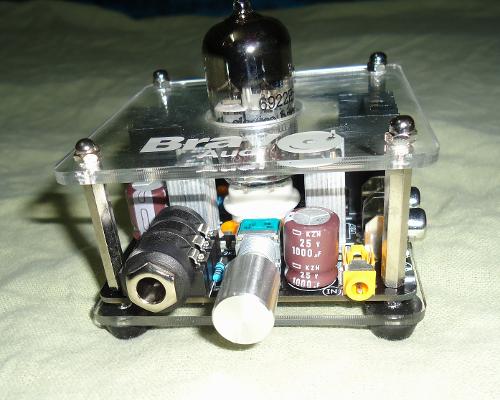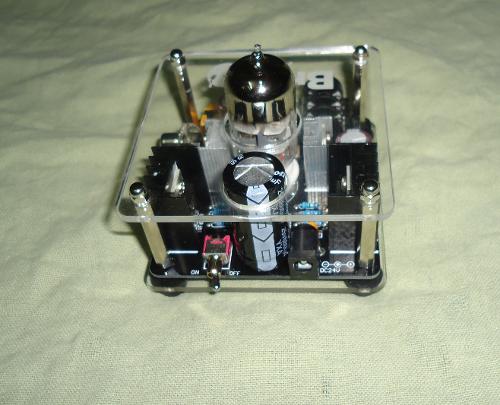Me: I am a 21 year old student living in a small town in India. I would like to call myself a music enthusiast, rather than an audiophile. I was inspired by music since childhood, and as the time passed, the passion of music grew in me, and that subsequently led me to join Head-Fi. Eventually, I found the pleasure of listening to music mainly by the HD600 and recently, by the seductive LCD2 headphones, and realized the true components of recorded music. I usually like to listen to Indian Classical Music along with Bollywood songs. My main listening genres include classical, vocal, instrumental, jazz and sometimes pop. With time, my sonic preferences have very much grown. I avidly admire transparency, accuracy along with neutrality, and currently my favorite headphones are K702, HD800 & K812, which I mainly run from my trusty M-Stage HPA-2.
Intro: Bravo Audio is a popular Chinese brand specializing in the area of tube headphone amplifiers in economical price. Bravo was established in 2010. Even though a relatively newer establishment in the field, Bravo managed to capture attention of the world by their amp offerings which had attractive price tag & appreciable performance. Back in 2010, tube/hybrid amps would be expensive, and out of reach of a humble Enthusiast. Bravo made well performing hybrid amps in an affordable price. Bravo was the one who made hybrid amps in sub 100$ category. This made them a well known name across the Audiophile World.

All of Bravo’s amps are hybrids, and are driven by Mosfet’s, and are pure class A. This ensures in mammoth output power, appreciable clear sound quality, but heat dissipation is high, and the amp physically gets hot even to touch comfortably. Bravo has been famous since its release of V1 (6922) & V2 (12AU7) amps, which were budget friendly, yet performing, which won ears of many enthusiasts. The V1 employs Electro Harmonix 6922EH tube. Both V1 & V2 are very similar in design, features & functions.
Specifications of V1:
Input Power: DC 24V 1.5A
Input Sensitivity: 100mV
Input Impedance: 100KOhm
Headphone Impedance: 20~600 Ohm
Frequency response: 10Hz-60 KHz +/- 0.25dB
Signal/Noise Ratio : >90dB Gain: 30dB
THD: 0.016% (300 ohm) 0.45% (33 ohm)
Let us see what the V1 amp has got for us,
Packaging and Accessories: The V1 amp arrives packed inside a general cardboard box, packed inside a removable foam packing. Packaging is generic, but nothing to complain about. But all the included accessories have a good quality and feel to them.
List of accessories in the box, which include the following:
Power Adapter: AC to DC 24V 1.5A power adapter EU/US/AU/UK is supplied as per specifications.
¼” Converter: A 1/8” to ¼” converter for headphones with 3.5mm Jack.
Design and Build: The V1 has a very good overall build quality. Though it is enclosed in open acrylic sheets to save manufacturing costs, it gives out funky DIY looks. The V1 looks much different& funky, and stands out from the crowd. Even then, the open case is of good quality transparent fibre & metal supporting beams. The transparent sheets make us gaze through it and onto the well soldered circuit board. The V1 is fairly small in size The V1 is light in weight, & weights under 250 grams.

At the front we have volume knob, ¼” headphone output socket & a 3.5mm input socket. At the rear side of V1, we can observe the presence of power socket & on/off toggle switch. Volume knob rotation is smooth and knob has just the right size for fingers. ¼” jack is also a very sturdy, but is slightly tight. The ¼” socket employs clip mechanism, which may cause scratches/damage on the headphone jack. Power switch has a good switching feel and strength, and is very precise in its job.

Internals quality is certainly good. The V1 amp has no manual wirings; everything is fixed on the PCB. Soldering & joints are very well done. Volume pot is well known Alps branded, which a plus for both volume control & audio quality. Please do note that the Mosfets run very hot, be sure not to touch anywhere near them, otherwise burn injuries are guaranteed!

Since the V1 amp follows Tube/Mosfet Hybrid design, there is a 9 pin vacuum tube socket present, in which we may roll any compatible 6922 family tubes. The default one is 6922EH from electro-harmonix, & does a great job in sound quality. There is a blue LED below the socket, which gives out a glow effect to the tubes.

I observe a drawback in the power supply, it is not earthed. I am at a loss of understanding why Bravo did not include a third earthing pin or ground to make the amp safe. Since it is a DC supply, few ripples will be present in the final output. These either cause light electrocution/sock or audibly raise noise floor of the amp. All Bravo amps use the same 24V 1.5A power brick, and are not grounded o earthed. So if you happen to find a better quality laptop power supply within this specification, then it is a plug in replacement or upgrade.
Sound: The V1 delivers a typical entry level tube amp sound quality with lot of audible distortions. Presentation is in such a way that, mids are little more intimate, with lows & highs sound tad more relaxed and laid back. The V1 is somewhat a economic counterpart of the V3 amp.
Burn in: I could not notice any major improvement by burn in. But let’s say a playback of about 20 hours provides few minor audible improvements, Bass prior to break-in is quite muddy & loose, and eventually it becomes a little more accurate and clean, Mids will sound more open & slightly forward, airy and natural. Highs become slightly smoother; soundstage will open up by a margin.
Tube rolling: One can roll enormous number of 9 pin 6922/6DJ8/7308 or equivalents. After much testing a few tubes from different, I could conclude, the stock one (6922) is indeed very good at its job, is optimal for the existing circuit parameters.
The gain is fixed at 30dB, which is on higher side and is certainly not recommended for IEM’s. This amp is extremely powerful and can drive any dynamic cans to insane loudness with just 40% of the volume used, which is at 11 o’clock. Anything above 12 o’clock is unbearably loud.
Lows: are not very accurate or precise, and are on ‘looser’ side; but have a good impact. Depth is decent enough.
Mids: Forward & intimate, are tonally very coloured and feels somewhat ‘artificial’
Highs: Not detailed, are grainy and have a spike in upper-highs.
Soundstage: Not airy or spacious, but is Intimate & closed in. For anyone who is looking for a good soundstage definition, V1 is not quite a performer when compared to V2 itself, which is a good performer in this area. But one should not expect sonic qualities like detail retrieval, accuracy or good imaging from this amp, owing to its economic cost & the V1 is one of the cheapest available tube amp today.
Overall, final sound deliverance is not very satisfactory, although it has good design. Bravo’s own V2 amp sonically performed far better than the V1.
Comparison: Bravo’s own V2 amp can be compared with V1, owing their vastly similar design & functions. Also, the price different is mere 10$.
Bravo V2: Same functions, features & design, and definitely performs better by sound. The V2 is more neutral, provides a much cleaner sound output with good soundstage definitions, when compared to the V1. The added bonus here is The V2 costs 10$ less than V1.
Verdict: The V2 edges out the V1 with overall better finer accuracy & neutrality in sound, finer power distribution.
Conclusion: Sonically, Bravo’s V1 amp did not perform up to my expectation. Since Bravo’s own V2 amp outperforms the V1 in 10$ less, the V1 may not be an optimal recommendation. Instead, the V2 is a good performer owing to its 12AU7 architecture. My recommendation will go towards V2 instead of V1. Otherwise the V3 amp is a very good performer for additional 10$, with same 6922 architecture.
Pros:
1) Build Quality: even though it is open by case, the V1 has a very good interior build. No compromise to be seen anywhere in exterior too. Circuitry is also neat & well built.
2) Rolling Capability: Enthusiasts can roll great number of tubes to alter the final sonic signature.
3) Driving Power: The V1 amp has a sheer output power. It definitely can comfortably drive any set of high impedance cans.
Cons:
1) Heat emission: Actually not really a con, it is quite normal for a hybrid mosfet driven amp. But during operation, the V1 amp gets very hot; it becomes very difficult for a user to touch the surface of amp more than 2 seconds. The mosfet heatsinks, which are exposed & are very hot.
2) Power Supply: The default power supply is not grounded, hence a fair change of light electrocution and audibly higher noise floor. Thus one needs to earth it by connecting the input cable to a grounded source (like PC, which will be earthed)
3) Sound Quality: Is not very satisfactory when compared to V2 amp, which performs better across the sound spectrum.
4) Value: Considering the above points, the V1 amp will not have a solid price/performance ratio. Bravo's own V2 amp performs better for 10$ less.

